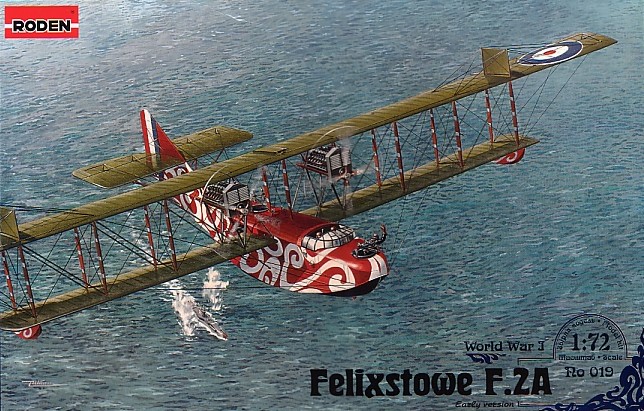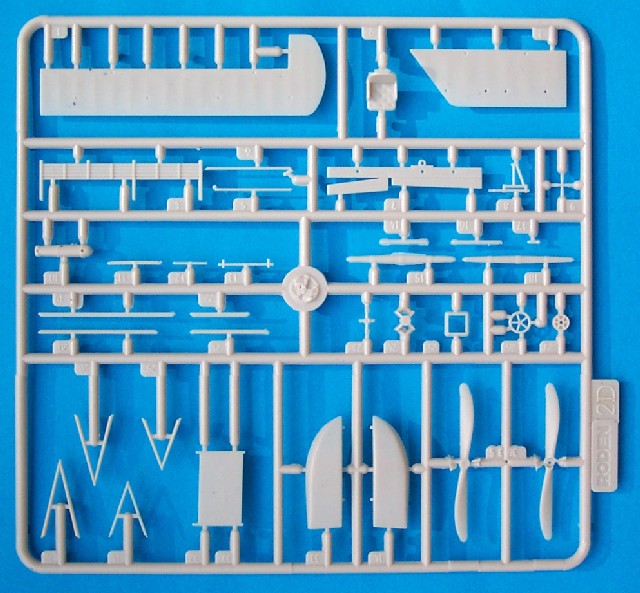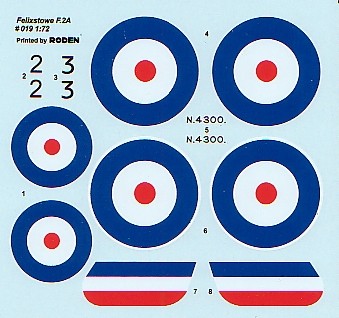|
Felixstowe F.2A
Early Version

Roden 1/72
S
u m m a r y
|
| Catalogue Number: |
Felixstowe F.2A “early version” Kit No.019 |
| Scale: |
1/72 |
| Contents and Media: |
236 parts in injection moulded
plastic; markings for four aircraft |
| Price: |
USD$19.96 from Squadron.com
|
| Review Type: |
FirstLook |
| Advantages: |
well researched, superb moulding,
razor sharp trailing edges, attention to detail, ambitious subject. |
| Disadvantages: |
Unclear rigging diagram. |
| Recommendation: |
Highly Recommended |
Reviewed by Robert Baumgartner

Roden's 1/72
scale Felixstowe F.2A is available online from Squadron.com
If you weren’t intimidated by the colour schemes in
Roden’s first kitting of this “flying boat” then you should be with this
release! The striking box art, which shows F.2A N4512 attacking a U-boat
on 8 June 1918, is typical of the high visibility markings that were
applied to many of these aircraft.
There are 236 cleanly moulded plastic parts and
decals for 4 options.
This kit concentrates on the early version of the
F.2A where the main distinguishing feature is the semi-enclosed cockpit.
For this, Roden replace sprue E from the previous
kit and substitute sprue G. This is necessary to provide a new two-piece
fuselage decking to accommodate the cockpit canopy.
The clear part for this semi-enclosed area is
nicely moulded with no visible distortion.
Another change, but this time more subtle, is the
inclusion of sprue D1 instead of one of the 2D sprues. This initially
looks exactly the same as the included sprue 2D but has propellers of a
different pitch orientation. Early versions were often seen with engines
of “opposite hands” (pre June 1918) so it is excellent that Roden have
supplied these parts.
The rest of the kit is as we have seen it in
Roden’s F.2A “late version”.

Click
the thumbnails below to view larger images:
None of the moulds have suffered over time and the
previous sharp detail of the earlier release remains.
One of the highlights of the kit is the wing. The
trailing edges are as sharp as you could ever want and the rib detail is
suitably restrained. The ailerons, tailplane, elevators, and rudder are
also to this standard and are a credit to the manufacturer. One thing to
be aware of with these parts is that Roden have over emphasized the
holes for the rigging, so it would be prudent to fill these and re-drill
your own.
For ease of assembly, the instructions suggest you
complete the wing cell before lowering it into the open topped fuselage.
The upper decking is then glued on top to hold everything in place. This
has the drawback of making the cleanup and painting rather awkward. I
found it just as easy to attach the lower wing only, glue the top deck
on, and then proceed from there.
The fuselage is nicely moulded with some detail
present on the inner surfaces. Other parts make up the full-length
floor, seats, steering wheels, gun positions and rudder pedals.
The Rolls Royce Eagle engines are kits in
themselves and comprise nearly 30 parts each. The fit will take some
juggling but the effort is well rewarded.
Roden are renowned for the moulding of their
machine guns and these are no exception.
They are petite and the high level of detail belies
their size.
A kit of this type doesn’t have an undercarriage
for the aircraft to safely be displayed on so Roden have thoughtfully
provided us with a beaching trolley. I was surprised that the finished
product fits as well as is does on top of this but one must still be
careful not to knock it over!
A basic rigging diagram is provided but this lacks
in some key areas. The instructions suggest referring to the box art and
this is an excellent resource. As such, it shows a three dimensional
aspect of what the instruction fail to show. Unfortunately after all
this, there are still some areas that need clarifying.
Four very colourful aircraft are catered for and
all of them will be challenging.

Felixstowe F.2A (early) N4283.
Flown by Flight Commanders G E Livock and R Leckie,
the black and white dazzle scheme on this aircraft will really test the
painter. Some parts of the fuselage were left untouched which contrasts
nicely with the PC10 (or possibly dark green) uppersurfaces.
Felixstowe F.2A (early) N4512.
The subject of the box art, this colourful example
reached Great Yarmouth in early 1918.
On 21 June, the crew tried to rescue a pilot who
ditched in the sea after experiencing engine problems in a 2F.1 Camel.
In doing so, N4512 itself crashed and soon sank below the surface.
Although the Felixstowe crew was rescued, Lieutenant Packe who was the
pilot of the Camel was unable to be saved.
Felixstowe F.2A (early).
This red and white striped example had the standard
scheme with the uppersurfaces of the wings, and tailplane in either PC10
or dark green. The undersurfaces of the wings were clear doped.
Felixstowe F.2A (early) N4300.
Those with a liking for blue will admire this
Saunders-built aircraft. It was received at Felixstowe in June 1918 and
was fitted with semaphore signaling equipment on the fuselage behind the
wing. This apparatus will have to be scratch built if modeling the
aircraft in this configuration.
It was a pleasure to find that the decals in my
example were in perfect register.
This is indeed a wonderful kit and one that must be
built with care. The parts fit well and as long as everything is
properly lined up, the assembly is pretty straightforward.
Highly Recommended
Thanks to
Squadron.com for the review
sample.
Review and Images Copyright © 2004 by
Robert Baumgartner
Page Created 21 June, 2004
Last updated 21 June, 2004
Back to HyperScale Main Page
Back to Reviews Page
|
Home | What's
New | Features
| Gallery |
Reviews | Reference
| Forum
| Search